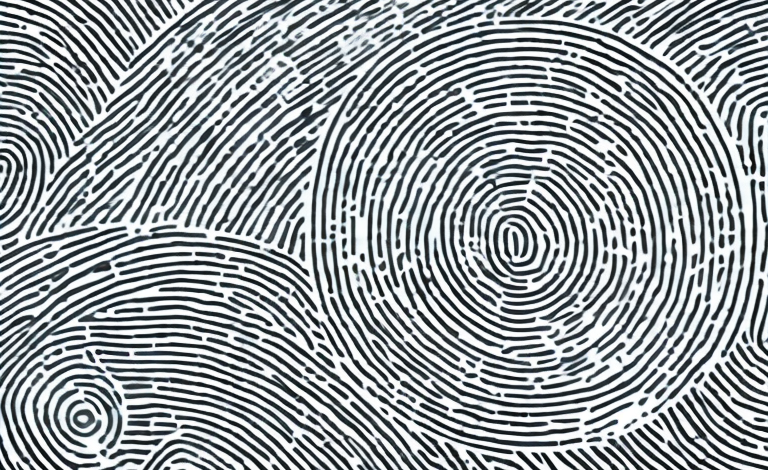Fingerprint identification is a widely used technique in criminal investigations to identify suspects and link them to crimes. It is considered to be one of the most reliable forms of evidence, but is it true that a fingerprint left on tape can really work? Let’s dive deeper into this topic and explore the science behind it.
The science behind fingerprint identification
Before we discuss whether a fingerprint on tape can be effective, let’s first understand the science behind fingerprint identification. A fingerprint is a pattern of ridges and valleys on the skin’s surface. These patterns are unique to each individual and remain unchanged throughout a person’s life. Fingerprint identification is based on the fact that no two individuals have the same fingerprint pattern.
The study of fingerprints is known as dermatoglyphics. Dermatoglyphics is a branch of science that deals with the study of the patterns of skin ridges on the fingers, palms, toes, and soles. The patterns on the fingers and palms are the most commonly used for identification purposes.
Fingerprint identification is a highly accurate method of identification. The accuracy of fingerprint identification is due to the fact that the patterns on the fingers and palms are unique to each individual. Even identical twins have different fingerprints. The accuracy of fingerprint identification is also due to the fact that the patterns on the fingers and palms remain unchanged throughout a person’s life, except in cases of injury or disease.
How do forensic experts use fingerprints to solve crimes?
Forensic experts use fingerprints to solve crimes by comparing the fingerprints found at a crime scene to a database of known fingerprints. If a match is found, it can be used to link the suspect to the crime. Fingerprint identification can also be used to exclude individuals who were not present at the crime scene.
In addition to identifying suspects and excluding innocent individuals, forensic experts can also use fingerprints to determine the sequence of events that occurred during a crime. For example, if multiple sets of fingerprints are found at a crime scene, experts can analyze the order in which they were left to piece together the movements of the individuals involved. This can provide valuable insight into how the crime was committed and potentially lead to the identification of additional suspects.
History of fingerprint analysis and its evolution
Fingerprint analysis has been used as a method of identification for over a century. Its first recorded use dates back to the 19th century. Over the years, the techniques used to lift, analyze, and compare fingerprints have evolved, making it a more precise and reliable form of evidence.
One of the major breakthroughs in fingerprint analysis came in the early 20th century when Sir Edward Henry developed a classification system that is still used today. This system categorizes fingerprints into different patterns, such as loops, whorls, and arches, making it easier to compare and identify them.
In recent years, advancements in technology have further improved the accuracy and efficiency of fingerprint analysis. Automated fingerprint identification systems (AFIS) use computer algorithms to match fingerprints against large databases, greatly reducing the time and effort required for manual analysis. Additionally, new techniques such as laser ablation and chemical enhancement have made it possible to recover fingerprints from surfaces that were previously considered too difficult to analyze.
Limitations of using fingerprints as evidence in court
While fingerprint identification is considered to be one of the most reliable forms of evidence, there are limitations to its use in court. One of the main limitations is that a fingerprint can only link a suspect to a crime scene, it cannot prove that they committed the crime. This is because it cannot establish when the print was left or by whom, and it is possible for someone to have left their fingerprint at a scene innocently.
Another limitation of using fingerprints as evidence in court is that the quality of the print can greatly affect its reliability. If the print is smudged or incomplete, it may not be possible to make a positive identification. Additionally, if the print is left on a surface that is difficult to lift prints from, such as a rough or porous surface, it may be impossible to obtain a clear print for analysis.
Factors that can affect the accuracy of fingerprint identification
Several factors can affect the accuracy of fingerprint identification. One of the main factors is the quality of the fingerprint itself. If the fingerprint is incomplete, distorted, or smudged, it can be difficult to make an accurate comparison. The experience and expertise of the person analyzing the print is also crucial in obtaining reliable results.
Another factor that can affect the accuracy of fingerprint identification is the condition of the surface on which the fingerprint was left. If the surface is dirty, oily, or wet, it can affect the clarity of the print and make it harder to analyze. Additionally, the age of the fingerprint can also play a role in its accuracy. Over time, fingerprints can fade or become distorted, making it more challenging to match them to a known print.
It’s also important to note that certain medical conditions or injuries can affect the appearance of fingerprints. For example, individuals with eczema or psoriasis may have distorted or missing fingerprints, while those with scars or burns on their fingers may have altered prints. These factors can make it more challenging to obtain accurate results and may require additional analysis or alternative methods of identification.
Differences between latent, patent, and plastic fingerprints
There are different types of fingerprints that forensic experts analyze. Latent fingerprints are those that are not visible to the naked eye and require specialized techniques to lift and analyze. Patent fingerprints are visible to the naked eye and are left by substances like blood or grease. Plastic fingerprints are left in materials like putty or wax and can be lifted by simply pressing a surface.
It is important to note that the quality and quantity of information that can be obtained from each type of fingerprint varies. Latent fingerprints, while more difficult to obtain, can provide more detailed information about the individual who left the print, such as their unique ridge characteristics. Patent fingerprints, on the other hand, may not provide as much detail but can still be useful in identifying a suspect. Plastic fingerprints are often less useful in forensic investigations as they can be easily distorted or destroyed.
Techniques used to lift and analyze fingerprints from various surfaces
Forensic experts use a variety of techniques to lift and analyze fingerprints from different surfaces. Some techniques include dusting, using chemicals like ninhydrin or cyanoacrylate, and even using lasers to enhance the print. The technique used depends on the type of surface and the quality of the print.
Dusting is a common technique used to lift fingerprints from non-porous surfaces like glass or metal. A fine powder, such as black carbon powder, is brushed onto the surface and adheres to the oils and sweat left behind by the finger. The powder is then lifted with tape or a special lifting device and transferred to a card for analysis. Chemicals like ninhydrin or cyanoacrylate are used to lift prints from porous surfaces like paper or cardboard. These chemicals react with the amino acids in the print and create a visible image. Lasers can also be used to enhance prints that are difficult to see. The laser light causes the print to fluoresce, making it easier to photograph and analyze.
The role of technology in enhancing fingerprint analysis and identification
The use of technology has greatly improved the accuracy and reliability of fingerprint analysis and identification. Advances in technology have made it possible to enhance prints, automate the comparison process, and develop databases of known fingerprints.
One of the most significant advancements in fingerprint technology is the use of live scan devices. These devices capture high-quality digital images of fingerprints, which can be easily stored and shared electronically. This has greatly improved the speed and efficiency of fingerprint analysis, as well as the ability to quickly identify suspects.
In addition, new software programs have been developed that can analyze and compare fingerprints more accurately than ever before. These programs use complex algorithms to identify unique patterns and features in fingerprints, which can then be compared to a database of known prints. This has greatly reduced the risk of human error in the identification process and has led to more accurate and reliable results.
Controversies surrounding the reliability of fingerprint evidence in criminal cases
While fingerprint identification is considered to be reliable, there have been controversies surrounding the use of fingerprint evidence in criminal cases. Some have questioned the accuracy and reliability of the identification process, arguing that it is subjective and prone to error.
One of the main concerns is the possibility of human error in the collection and analysis of fingerprint evidence. If the fingerprint is not properly collected or analyzed, it can lead to false identifications and wrongful convictions. Additionally, there have been cases where fingerprint evidence was mishandled or contaminated, leading to unreliable results.
Another controversy surrounding fingerprint evidence is the potential for bias and discrimination. Studies have shown that certain factors, such as race and age, can affect the accuracy of fingerprint identification. This has raised concerns about the fairness of using fingerprint evidence in criminal cases and the potential for it to disproportionately impact certain groups.
The future of fingerprint identification and its potential impact on law enforcement
The future of fingerprint identification looks promising with the continued development of technology and techniques. One potential impact is the creation of more accurate and efficient databases of known fingerprints, which can aid in solving crimes. It is clear that fingerprint identification will continue to be a valuable tool for law enforcement in identifying suspects and linking them to crimes.
In conclusion, while a fingerprint on tape can be effective, the reliability of the identification process largely depends on the quality of the print and the techniques used to lift and analyze it. Fingerprint identification remains a valuable tool for law enforcement in solving crimes, but it is important to consider the limitations and potential for error in using this type of evidence in criminal cases.
Another potential impact of the future of fingerprint identification is the development of new techniques for analyzing and interpreting fingerprint evidence. For example, researchers are exploring the use of artificial intelligence and machine learning algorithms to more accurately match fingerprints to known individuals. This could lead to faster and more reliable identifications, as well as the ability to identify individuals who have altered their fingerprints in an attempt to evade detection.
Additionally, the future of fingerprint identification may also involve the integration of other biometric data, such as facial recognition and DNA analysis. By combining multiple forms of biometric data, law enforcement may be able to more accurately and quickly identify suspects and solve crimes. However, it is important to consider the potential privacy concerns and ethical implications of using such advanced technologies in law enforcement.



